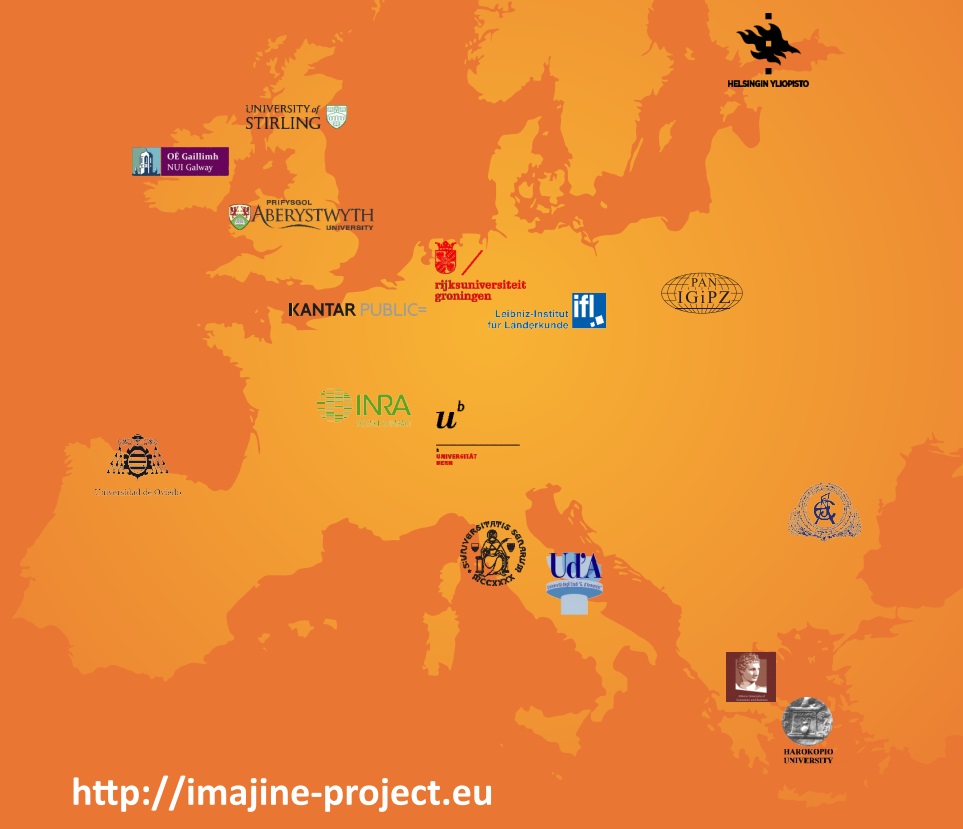IMAJINE has adopted a multi-disciplinary, multi-scalar and mixed method approach that embodies the principles of co-production with governmental and civil society actors. IMAJINE is an ‘idea to tested proposal’ project in relation to policy development, with stages involving the review and development of concepts; collection, analysis and integration of new empirical data; formulation and testing of policy scenarios; and proposal of recommendations for policy revisions and new policy instruments.
The adoption of a multi-disciplinary and mixed method approach to research in IMAJINE follows from the conceptual framework of spatial justice that directs attention to the multi-dimensional social, economic, political and environment aspects of territorial inequalities, the relational and socially constructed nature of space, and the normative and political questions that are implicit to the evaluation of spatial justice.
In order to address this broad canvass of enquiry, IMAJINE incorporates perspectives from fields including economics, human geography, political science, psychology, sociology and spatial planning, and combines qualitative and quantitative research methods, working with both primary and secondary data at a range of scales. These include:
- Disaggregation and quantitative analysis of spatial data on indicators of socio-economic inequalities, including application of standard measures for identifying inequalities from spatial data (standard deviation, coefficient of variation, Gini coefficient) and examination of changes with the Theil index; exploratory spatial data analysis (ESDA)
and exploratory spatial-temporal data analysis (ESTDA) to isolate spatial effects and to trace longitudinal trends; and assessment of spatial income distribution using recent innovations in decomposition methods. - These analyses will be performed for different indicators of inequality, including GDP per capital, average household income, educational attainment, employment, and population at risk of poverty and exclusion (AROPE). In order to conduct more nuanced analyses of territorial inequalities at scales beneath NUTS 2 regions, and to overcome inconsistencies in the availability of data for these local scales between EU member states, spatially disaggregated data will be estimated for local territorial units using the entropy econometrics approach.
- Econometric analysis of spatial socio-economic data to investigate relationships between forms of economic and political governance and levels of economic development and growth, involving the use of cross-section and panel regressions to identify territorial groupings that assume different behaviour in economic growth; consideration of β-convergence models to investigate the impact of income inequality on economic growth at the local level; and estimation of the heterogeneity in the effects of cohesion policy conditional on geographical factors, and of the marginal returns of each type of investment to GDP growth and employment.
- Quantitative analysis of the redistributive effects of taxes and transfers using the tax-benefit microsimulation model EUROMOD.
- An experimental public attitude survey, examining perceptions of territorial inequalities, attitudes towards regional autonomy and territorial cohesion, and feelings of solidarity within and across nations. The experimental questionnaire methodology will use scenario building and factorial designs to explore whether and to what extent different criteria and contextual situations affect citizens’ preferences. The survey will be administered through Computer Assisted Web Interviewing (CAWI) to a total sample of 8,000 respondents in seven countries (France, Germany, Italy, Poland, Romania, Spain and the UK), with booster samples in selected case study regions.
- The collection and analysis of qualitative data, through semi-structured interviews with national, regional and local stakeholders in government institutions and civil society organizations, activists in territorial autonomy movements, and migrants to and from selected case study regions and populations; focus groups with regional stakeholders; and textual analysis of policy documents, regional development programmes manifestos and political literature, and official speeches, including the use of novel data scraping techniques and of computer-assisting coding using MaxQDA software.
- Participatory Scenario Building involving participants from grassroots community groups and agencies engaged with issues around inequality in case study regions to construct scenarios for future policy options to address territorial inequalities. The evidence base for the participatory scenario building exercises will be drawn from the preceding work packages in IMAJINE, combining quantitative and qualitative data using a causal loop diagram approach.
The IMAJINE research will primarily cover the eleven case study countries of Finland, France, Germany, Greece, Ireland, Italy, Netherlands, Poland, Romania, Spain and the UK. Some aspects of the research, notably the spatial disaggregation of data and initial quantitative analysis of territorial inequalities, will extend more widely across European countries for which appropriate data is available. Other elements may be focused on a smaller set of case study countries or regions, to permit deeper analysis.

